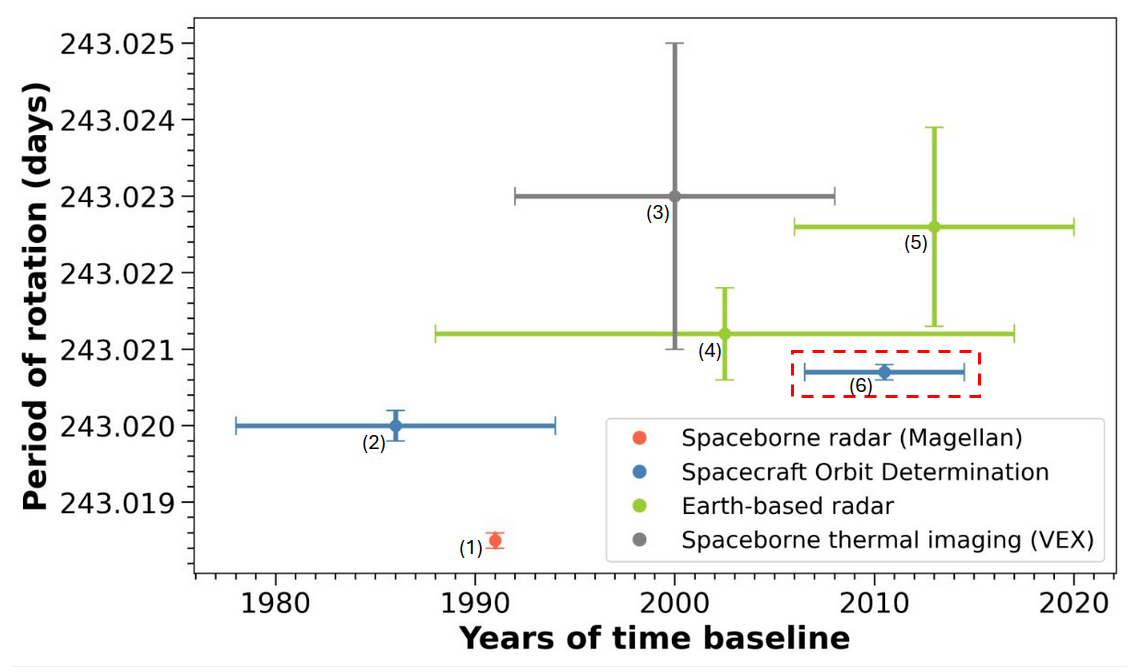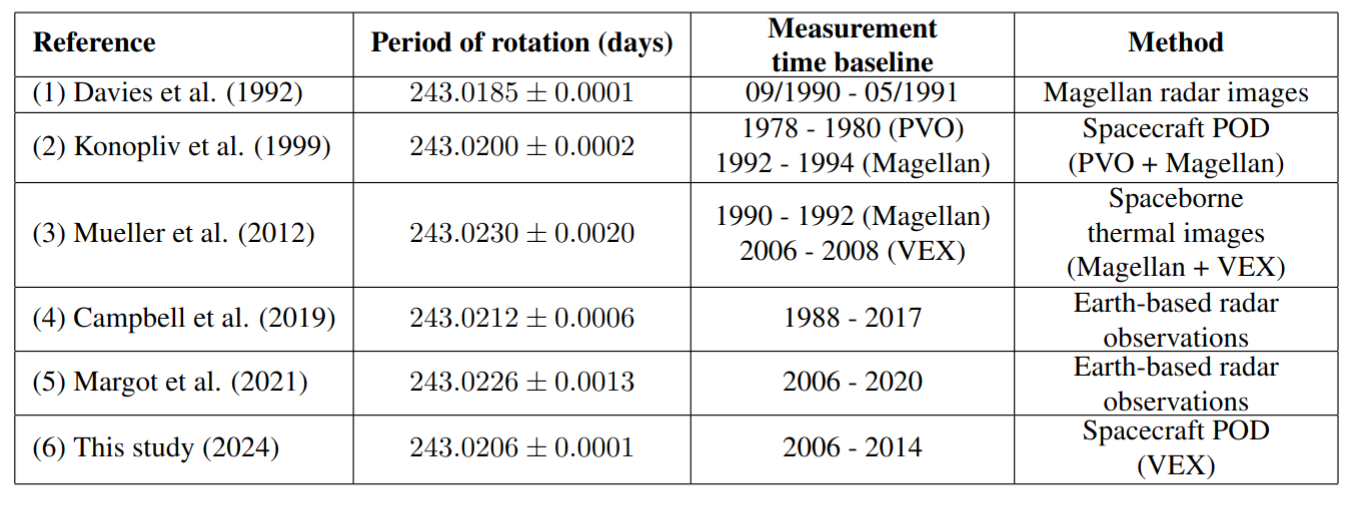Determination of Venus’ rotation state using radio-tracking data from the Venus Express spacecraft
- 1Laboratoire de Planétologie et Géosciences, UMR-6112, Nantes Université, Université d’Angers, Le Mans Université, Nantes, France (maeva.levesque@univ-nantes.fr)
- 2CNES-Space Geodesy Office, Toulouse, France
- 3Rheinisches Institut fuer Umweltforschung, Abteilung Planetforschung, Cologne, Germany
Abstract
Venus remains a relatively unknown planet. The aim of this study is to determine the Venus' rotational state using the Precise Orbit Determination (POD) method with radio tracking data from Venus Express (VEX) spacecraft. We found a spin period of 243.0206 +/- 1.0028 x 10-4 days. This value is consistent with those found in the literature using different methods.
Introduction
Although Venus is often considered as the Earth's twin sister, our knowledge of its internal structure, including the size and state of its core are limited [1]. Its rotational state, although measured by several techniques (from the orbit or from ground-based radar), is not very well constrained and shows temporal variations that remain unexplained [2]. The Venus Express (VEX) spacecraft was launched by the European Space Agency (ESA) in November 2005 and orbited the planet for nearly 8 years, from mid-2006 to 2014. This mission was dedicated to the study of the atmosphere of the planet, however, the radio-tracking data performed for navigation purposes can also be used to determine the rotational state of the planet.
Method
This study investigates the Doppler tracking data acquired by ESTRACK Network and collected by VEX Radio Science Experiment (VeRa). The data were analyzed by using the Precise Orbit Determination (POD) method. It consists of performing an iterative least-squares adjustment between Doppler data generated form a numerical integration of a force model driving spacecraft's motion and observed tracking data on successive data arcs of 7 days. For this purpose, we use the GINS (Géodésie par Intégrations Numériques Simultanées) software, developed by French space agency (CNES).
As outputs, two kinds of parameters are fitted: the local and global parameters. Local ones correspond to parameters calculated for each arc whereas the global parameters are derived from all data-arcs. The rotational state of the planet is part of global parameters such as coefficients of its gravity field and the Love number k2.
Results
We found a spin period of 243.0206 +/- 1.0028 x 10-4 days. This result is consistent with previous solutions obtained using different tracking data (PVO, Magellan) or methods, such as radar or thermal images form the ground or spacecraft. Figure 1. represents some estimates of Venus' rotation period with respect to their measurement time baseline since 1980. References and methods used for these studies are listed in Table 1.

Figure 1 . Estimates of Venus' rotation period, along with their measurement time baseline and corresponding error bars (1 sigma). The outcome of our study is highlighted in red.

Table 1. References for estimates of Venus' rotation period rotation presented in Figure 1.
Spin period varies- from 243.018 days to 243.023 days, corresponding to a difference of approximately 7 minutes. Furthermore, we observe that the determined values differ depending on the method employed. Our study is in good agreement with the value from Konopliv et al. (1999), who employed the same method as us, as well as the result reported by Campbell et al. (2019) which used Earth-Based radar images. However, our spin period differ from that reported by Margot et al. (2021) end those using other methods such as spaceborne radar [5] or thermal imaging [6].
Conclusion
In this study, an estimate of Venus' rotation period is provided. This result is consistent with the values published in the literature. It shows that navigation tracking data of planetary orbiters, such as VEX, can also be used for science investigation. Further work is ongoing to constrain other geophysical parameters that may help us to better understand Venus.
Acknowledgements
The authors want to thank Bernd Häusler and the VEX Radio Science Experiment (VeRa) team, the Centre de Calcul Intensif des Pays de la Loire (CCIPL) and the ESOC Flight Dynamics.
References
[1] Dumoulin, C. et al.: Tidal constraints on the interior of Venus, J. Geophys. Res. Planets 122, 1338–1352, 2017
[2] Cottereau, L. et al.: The various contributions in Venus rotation rate and LOD, Astron. Astrophys. 531, A45, 2011.
[3] Konopliv A. S. et al.: Venus Gravity: 180th Degree and Order Model. Icarus 139, 3–18, 1999
[4] Margot, J. L. et al.: Spin state and moment of inertia of Venus, Nat Astron 5:676–683, 2021
[6] Mueller, N. T. et al.:Rotation period of Venus estimated from Venus Express VIRTIS images and Magellan altimetry, Icarus 217, 474-483, 2012.
[7] Campbell, B. A. et al.: The mean rotation rate of Venus from 29 years of Earth-based radar observations, Icarus 332, 19-23, 2019.
How to cite: Lévesque, M., Rosenblatt, P., Dumoulin, C., Marty, J.-C., and Pätzold, M.: Determination of Venus’ rotation state using radio-tracking data from the Venus Express spacecraft, Europlanet Science Congress 2024, Berlin, Germany, 8–13 Sep 2024, EPSC2024-489, https://doi.org/10.5194/epsc2024-489, 2024.